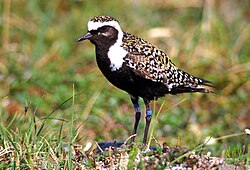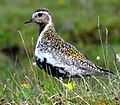| Pluvialis | |
|---|---|
 | |
| American golden plover (Pluvialis dominica) | |
| Scientific classification | |
| Kingdom: | Animalia |
| Phylum: | Chordata |
| Class: | Aves |
| Order: | Charadriiformes |
| Family: | Charadriidae |
| Subfamily: | Charadriinae |
| Genus: | Pluvialis Brisson, 1760 |
| Type species | |
| Charadrius apricarius (= Pluvialis apricaria ) Linnaeus, 1758 | |
| Species | |
see text | |
Pluvialis is a genus of plovers, a group of wading birds comprising four species that breed in the temperate or Arctic Northern Hemisphere.
In breeding plumage, they all have largely black underparts, and golden or silvery upperparts. They have relatively short bills and feed mainly on insects, worms or other invertebrates, depending on habitat, which are obtained by a run-and-pause technique, rather than the steady probing of some other wader groups. They hunt by sight, rather than by feel as do longer-billed waders.










